Heated towel rail: all causes and solutions
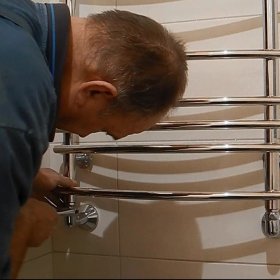
The heated towel rail installed in almost every bathroom (or “towel”, as it is lovingly called by the people) serves not only to dry small things, but also to heat the room. Unfortunately, situations when the device operates with reduced heat dissipation are not something extraordinary, and can occur both during operation and immediately after installation. Timely troubleshooting is the key to comfortable warmth and the availability of warm towels, so every home owner should understand the causes of malfunctions and find suitable ways to eliminate them.
Content
Why the water heated towel rail is not heated
An analysis of the situation with heated towel rail malfunctions (abbreviated PS) shows that there is a violation of their thermal efficiency for several reasons:
- improper installation;
- unskilled interference in the work of engineering structures;
- general condition of heating systems and hot water supply;
- quality and flow parameters of the coolant.
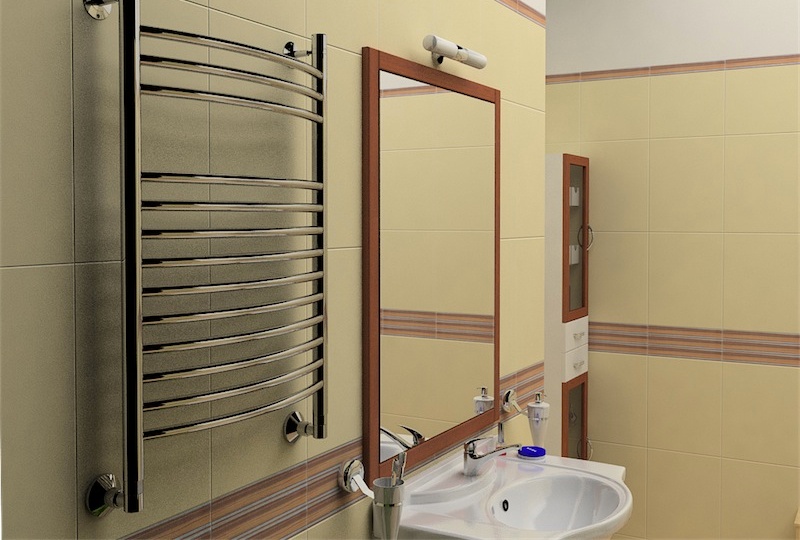
In order for the heated towel rail not only to look good in the interior, but also to provide effective heating, it is necessary to carry out a connection in accordance with the laws of hydrodynamics
As you yourself understand, it is almost impossible to influence the last circumstances. All that can be done in this case is to try to force the public utilities to fulfill their direct responsibilities. But to check the correct connection and find the "weak link" in the chain heated towel rail-hot water system can any more or less educated person. But first, let's figure out how the heater can be powered, and find out the reasons for the drop in its heat output.
Typical schemes for including heated towel rails
In the houses of the old housing estate, a section of the riser curved in the form of the letter “C” or “M” was used to heat the bathrooms and bathrooms. The simplicity of such a PS, however, has a number of advantages. Being connected in a dhw circuit in series, the device ensures a constant temperature, excludes interference in the operation of the system of other residents and has practically no effect on the hydraulic resistance of the main.
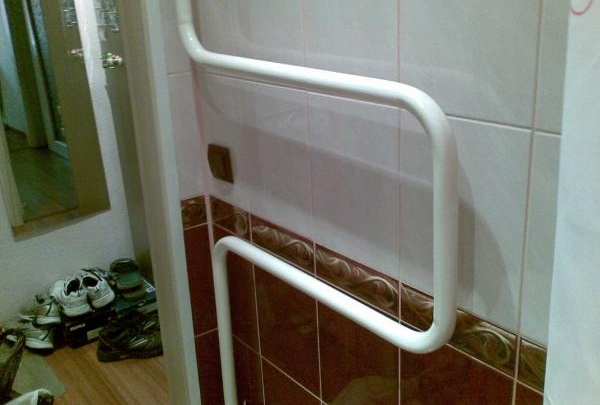
The heated towel rail in the form of a section of the riser, although it has an unsightly appearance, is at the same time the most unpretentious heating device
With the advent of more aesthetic stainless steel heated towel rails, it became necessary to replace previous appliances with the least interference with the heating system. The situation when the inner diameter of the riser is equal to the cross-section of the contour of the new substation can be considered ideal. Of course, if the heating device is embedded using couplings and shafts of the corresponding diameter.

A full replacement of the simplest heated towel rail with a modern stainless steel device is possible only if fittings with a full bore are used - there can be no question of installing ball valves
Before proceeding with the analysis of the connection schemes for heated towel rails, it is necessary to find out which engineering system - heating or hot water supply it is connected to. The fact is that the heating device will work only in hot water systems with a constantly circulating coolant. In the case of the use of the so-called deadlock scheme, the substation will be heated only when the tap with hot water is open.
If cranes and fittings are used to connect the heated towel rail, or if the new heating device consists of pipes of a smaller diameter than the riser, then a bypass must be used. Being, in fact, a workaround for the coolant, this simplest device makes it possible:
- maintain circulation of the coolant along the riser, even if the substation is connected by pipes of minimum diameter;
- adjust the temperature of the substation or dismantle it without affecting the common heating system or hot water supply (installation of shut-off valves or thermostatic device is required);
- By passing the main coolant flow through itself, the bypass ensures a constant coolant temperature for all apartments in the house.
Over time, developers refused to install the simplest substations, leaving residents with the right to choose and install a heating device. To do this, they began to draw conclusions on the riser under the heated towel rail, while at the same time ensuring a normal flow of coolant in a direct or offset bypass. I must say that there is absolutely no reason to worry about the operability of such schemes - water will be guaranteed to circulate through the heating device thanks to the principle of the “gravity pump”. It is based on the fact that the cooling coolant goes down and is replaced by masses of hotter water coming from above.
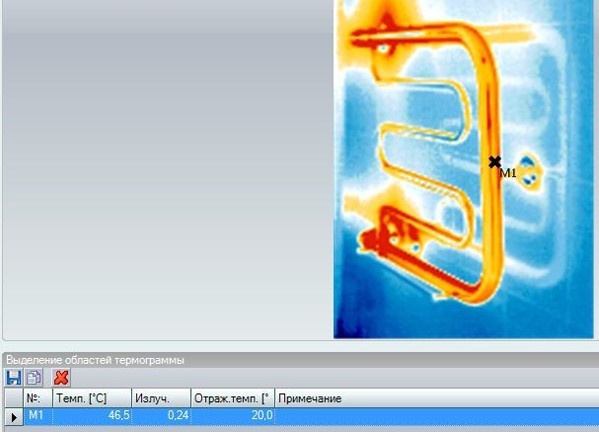
The thermogram of a heated towel rail operating on natural circulation indicates the high thermal efficiency of the “gravity pump”
For the same reason, the installation of substations is considered to be most effective, in which the coolant is supplied to the upper part of the heating device and taken from below. This condition can be ensured both with lateral and diagonal connection.
The opinion that the latter method has an advantage in terms of flow velocity and thermal efficiency is greatly exaggerated. Nevertheless, one of the best schemes is considered to be one in which the coolant flows to the near upper corner, and the return is connected to the remote lower one.
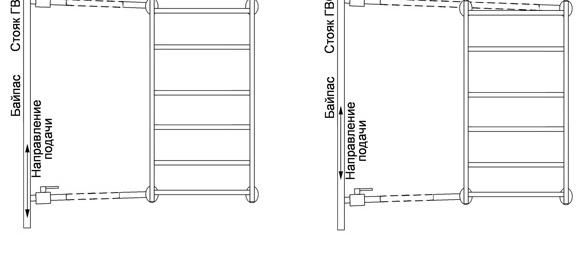
Lateral direct or diagonal connection will not bring any surprises if you make the connection taking into account the necessary biases
In this case, the PS performance does not depend on the speed and direction of the coolant supply, and the risk of airing the device tends to zero. The only condition is that at the same time slopes of at least 3 mm per 1 line must be observed. m highway.
With lateral connection, it does not matter at all whether the PS is between the feed and return points or extends beyond them.The only thing to consider is a significant increase in the risk of airing the device if its upper part is above the branch along which the heated towel rail is connected to the riser.

Installation of a heated towel rail above the tie-in point in the trunk increases the risk of air congestion - in this case, the installation of an air vent (Mayevsky crane)
The lower connection of the heating device is considered less effective and may cause its unstable operation.
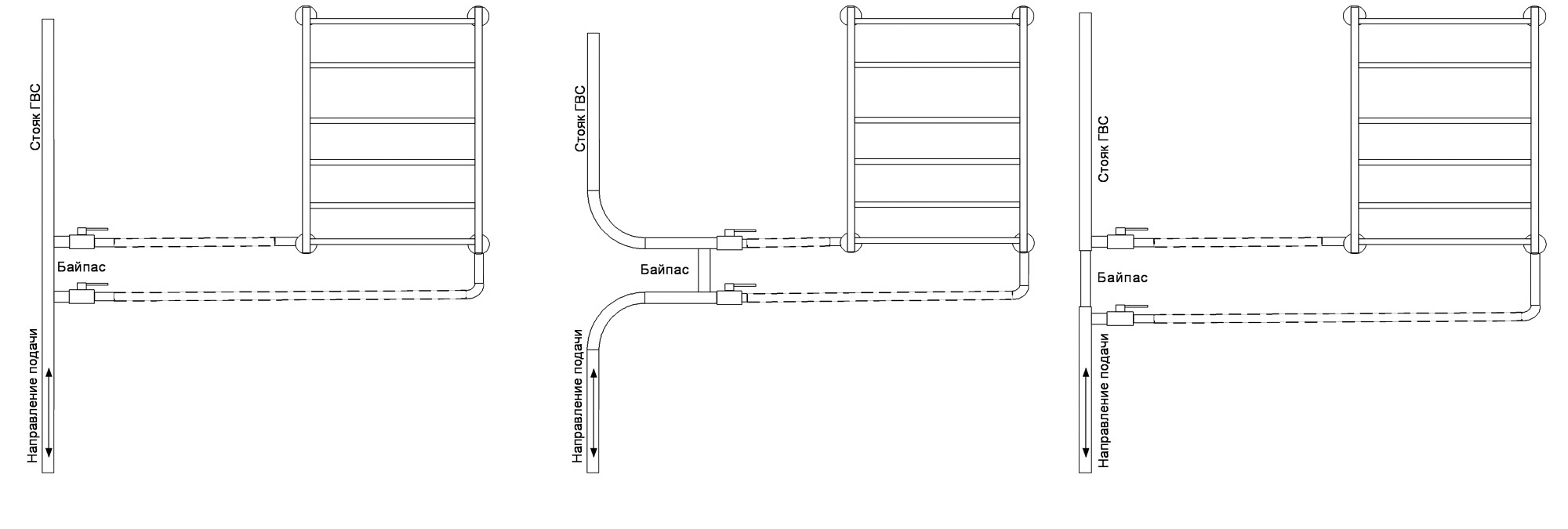
The operation of heated towel rails with bottom connection depends very much on the pressure and direction of the coolant supply, therefore several connection schemes are used - with a direct, offset or narrowed bypass
This type of installation is recommended to be used only with the upper flow, as well as in systems with forced circulation of the coolant.
Factors that lead to a decrease in the efficiency of the heating device
So, you are unhappy with the work of your heated towel rail and are looking for the reason that the heating device remains cold. The culprit of such a nuisance may be one of the following factors:
- When installing a heated towel rail, the features of the hot water system were not taken into account or the elementary laws of hydrodynamics were completely ignored. For normal operation of the heating device, you will need to connect it according to the rules, and possibly transfer it closer to the riser.
- Air in the PS circuit. The formation of an air congestion can cause a complete cessation of the circulation of the coolant through the heated towel rail. Air removal does not cause problems if the device is equipped with a special device - Mayevsky crane. For this reason, it is important to install an air vent even at the stage of installation of the heating device.
- Blockages. It is no secret that in our country most engineering systems have been in operation since stagnation, and the coolant does not differ in chemical (and physical) purity. For this reason, rust, scale and dirt accumulate inside the pipes. The presence of many roundings and corner joints makes the heated towel rail extremely vulnerable - deposits can not only reduce its cross-section, but also completely stop the circulation of hot water. You can clean the device both mechanically and chemically. Of course, it is better to provide for the possibility of removing PS even at the installation stage. To do this, shut-off valves are installed on the supply and return pipelines.
- Insufficient coolant supply pressure. Too weak hot water flow can occur either due to worn-out and clogged pipes, or due to a violation of the supply parameters of the coolant by the supplying organizations. Often, a decrease in pressure occurs due to interference in the operability of the system of people living in neighboring apartments.
- Lack of hot water. To solve this problem, you need to contact the management company.
- Installation of a heated towel rail in systems with dead-end water supply. The lack of constant circulation of the coolant makes the operation of the heating device episodic. To correct such a misunderstanding, you should power the device from the heating circuit. And so that the heating of the “towel” does not depend on the heating season, you can install a combined type device.
After analyzing the likelihood of a factor, you can begin to troubleshoot.
Eliminate the causes of inefficiency
Although the heated towel rail is a fairly simple device, it can be difficult to find the cause of inefficient operation. To reduce time and not to do unnecessary work, the search for the "weak link" is carried out according to a certain algorithm:
- carry out the airing of the heating device;
- determine the pressure of hot water at the entrance to the heated towel rail. This can be done both with a special device - a manometer, and using one of the calculation methods;
- analyze and eliminate the causes that lead to a drop in pressure in the circuit;
- the heated towel rail is removed and cleaned of dirt and deposits.
If the heated towel rail does not heat up at normal pressure in the domestic hot water system and good throughput of the circuit, then it is installed incorrectly. In this case, it is necessary to change the connection diagram, and possibly transfer the device to another location. We will move on to a discussion of installation errors and how to fix them a bit later. Now let's recall the simplest methods to solve the problem.
How to remove air jams
You can check whether the air plug is the cause of the trouble and remove it from the heated towel rail using a special air vent, also called a radiator air valve or a Maevsky cock. To do this, the locking screw (needle) of the valve is turned out of the seat so that air begins to sizzle out of the radiator with a hiss.
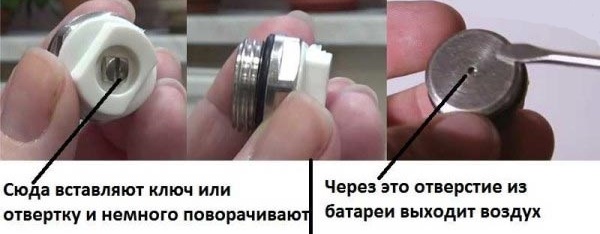
The process of removing the air plug with the help of a Mayevsky crane does not cause difficulties - any home master can handle this procedure
You can determine the end of the process by a thin stream of water without bubbles and hissing, which will begin to flow out of the valve opening. After that, the Mayevsky crane is shut off and a check is made to see if the coil begins to heat up.
If the heated towel rail is built into the individual heating system, you can’t do without airing one device - you will need a comprehensive removal of air from the entire system, starting from the boiler and ending with a radiator in each room. In systems with forced circulation of the coolant, it is better to turn off the pumps - this helps to prevent the movement of air jams and contributes to their complete removal.
Often, our readers are faced with a situation where the heated towel rail was originally mounted without an air vent. In this case, we recommend installing this useful and inexpensive device - in the future it will be able to save you a lot of time and effort.
As a temporary measure, air bleeding through depressurization of the circuit can be recommended. To do this, you need to stock up some capacity (a bowl or a bucket), and lay a rag on the floor under the PS. Next, slightly unscrew the top nut, with which the "towel" is connected to the riser. In this case, water mixed with air bubbles will begin to ooze out from under the compound. After waiting until the hissing stops, the tightness of the system is restored.
Video: how to bleed air from a heated towel rail
How to get rid of blockages
In the old "stalinkas" and "Khrushchevs" engineering communications are so worn out that clogging and gusts due to rusty pipes are as commonplace as airing. To eliminate clogging, turn off the water and disconnect the heated towel rail from the riser. In this case, a few liters of water remain in the coil, so it is better to substitute some empty bowl or bucket under it.
To determine in which part of the circuit there is a blockage, a hose with a good water pressure is connected to one of the exits of the heated towel rail, and the second is lowered into an empty container or bath.A decrease in water pressure indicates that the coil needs cleaning.
Both mechanical and chemical methods are used to remove internal deposits. In the first case, you can use a plumbing cable with a small homemade brush at the end. It is introduced inside and translational-rotational movements clean the walls of the device from scale and rust.
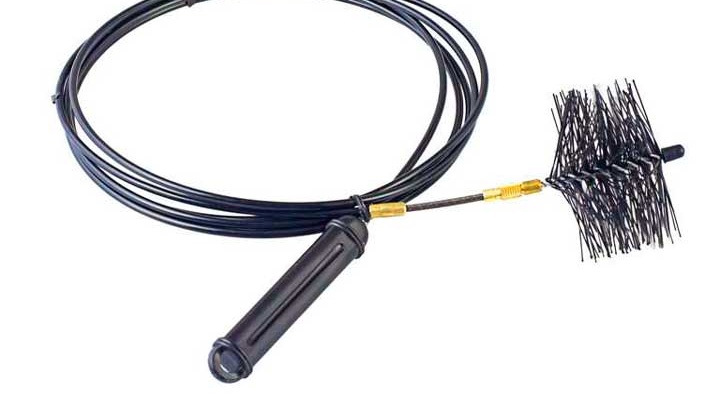
To clean the inner surface of the heated towel rail and pipes of the heating system and hot water supply, you can use a plumbing cable with a metal ruff
In case of severe pollution and the presence of persistent deposits, special chemicals such as “Mole”, “Mr. Muscle”, “Deboshir”, etc. cannot be dispensed with. Dissolved chemicals are poured into the device installed upside down and kept for the time indicated on the package.
Along with household chemicals for cleaning towel warmers, you can use folk remedies. For example, a combination of acetic acid and ordinary baking soda, poured into a heating device, gives a good result.

The most persistent deposits of rust and scale can be removed by dry cleaning by hydrodynamic method
In the case when the pressure drop is due to old, clogged pipes, you can try to restore their patency with a plumbing cable. If this option does not give the expected result, then one of the companies providing hydraulic pipe cleaning services (using high pressure installations) can be involved in solving the problem.
What to do if the circulation in the DHW circuit is disturbed for subjective reasons
When searching for causes that lead to a decrease in pressure, one cannot discount the human factor. Most often, the heated towel rail is included in the return DHW line with constant circulation, due to which it is possible to maintain the temperature of hot water within specified limits. In order to ensure equal thermal conditions for each consumer, all branches from the riser are equipped with bypasses. Thanks to these simple sections of the pipeline, it is possible to avoid a significant difference in the temperature of hot water between the first and last point.
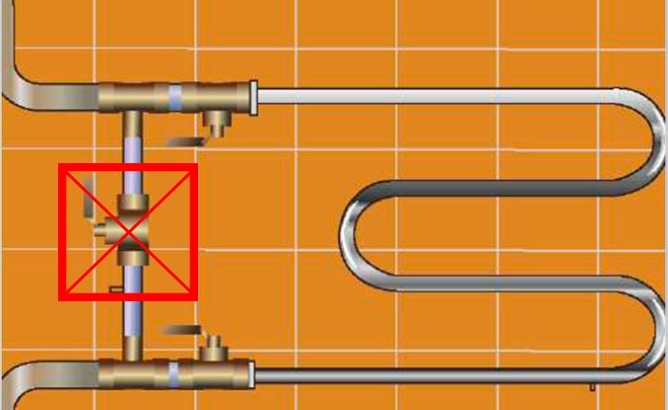
The installation of taps and plugs on the bypass is prohibited, as it changes the hydrodynamic characteristics of the DHW system
In order to increase the temperature of the substation in a separate apartment, it is enough to shut off the bypass with a ball valve - in this case, the entire flow of hot water will go through the heating device. The result of such "innovations" is a drop in temperature and an increase in the hydraulic resistance of the system. You can guess for yourself that several “rationalizers” living in your stairwell are able to leave the bathrooms of all other apartments without heat. That is why to carry out work that can change the hydrodynamic parameters of the DHW system is prohibited by law.
Another example of an irresponsible attitude towards communal utilities is the removal of a heated towel rail formed by bending the riser without restoring the integrity of the latter. In other words, one of the neighbors during the repair carved an unaesthetic design by installing plugs at the ends of the pipes. In this case, bypassing this apartment, it is necessary to install a jumper from the same pipe with which the riser is made.
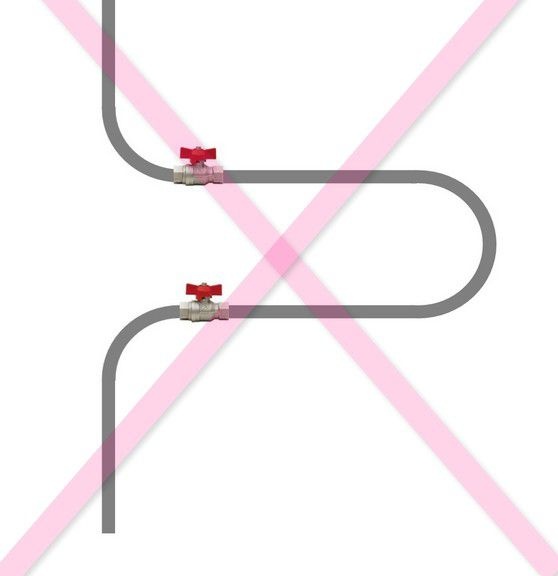
Installation of stop valves on the riser is prohibited not only in order to avoid the interference of residents in the operation of the DHW system, but also due to an increase in the hydraulic resistance of the main
According to sanitary standards, it is only possible to turn off the hot water supply in case of repair or preventive maintenance, therefore substations must be heated in any season. In reality, with the end of the heating season, the housing office often disconnects the return branch in the DHW circuit, transforming the circulation circuit into a dead end.In this case, the heater will only work when the “hot” tap is opened.
If you are sure of the correct installation and serviceability of communications, you should talk with your neighbors or apply with a complaint to the management company. If this does not help, then you have two options for solving the problem. The first is to become the same intruder by reconnecting to the DHW supply branch, shutting off the bypass or installing an additional circulation pump. The second - remaining a law-abiding citizen, power the device from the heating system or install an electric (combined) device.
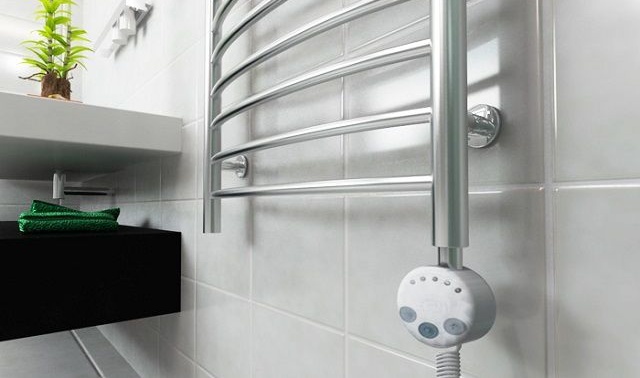
Modern electric heated towel rails are equipped with temperature regulators that allow you to adjust the temperature of the device over a wide range
We fix installation errors
All the methods described above for restoring the capacity of a heated towel rail are quite simple even for people who first picked up an adjustable wrench. The situation with the heated towel rail, which was installed with violations of the laws of thermodynamics, causes much more difficulties.
One of the most common errors is a side or bottom connection, in which the heating device (in whole or in part) is installed below the insertion point of the return pipe into the riser. In this case, gravitational forces are not enough to create the pressure necessary to raise the cooled layers of the coolant to the level of the return pipe. Of course, natural circulation in this case will not work.
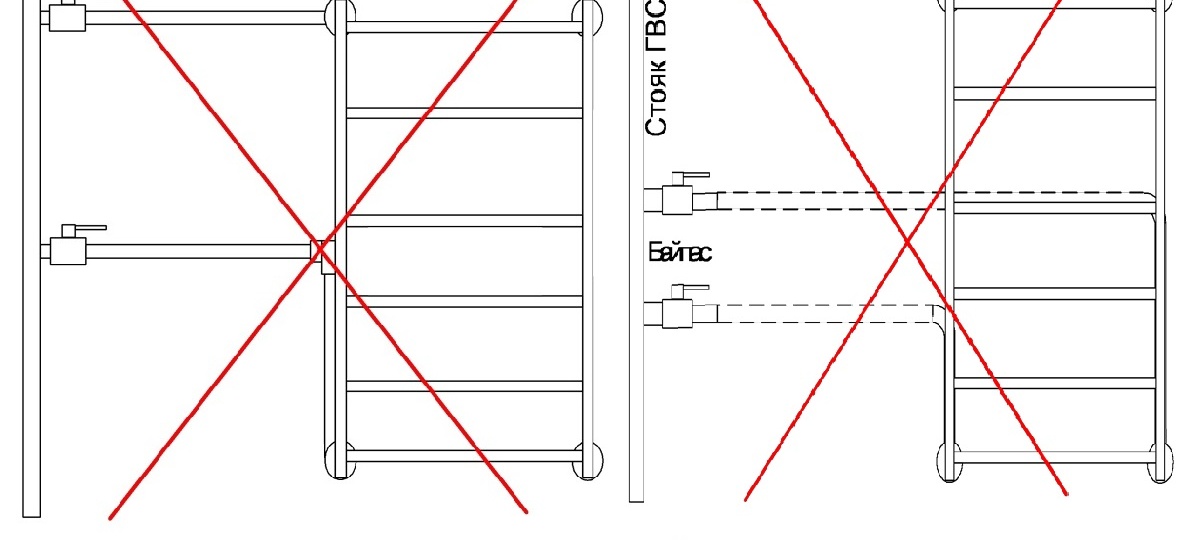
An error in the form of mounting a return line above the lower point of the heated towel rail makes it impossible to circulate the coolant
Often, for the sake of convenience and aesthetics, negligent craftsmen connect a heated towel rail, hiding the supply pipe behind a suspended ceiling, and lay the return pipe under the floor. The “loop” located on the feed section is an excellent trap for air bubbles - the cork formed in this place is very likely to block the path to the water flow. As for the lower “loop”, it prevents the expulsion of the cooled coolant for the reasons already discussed above.
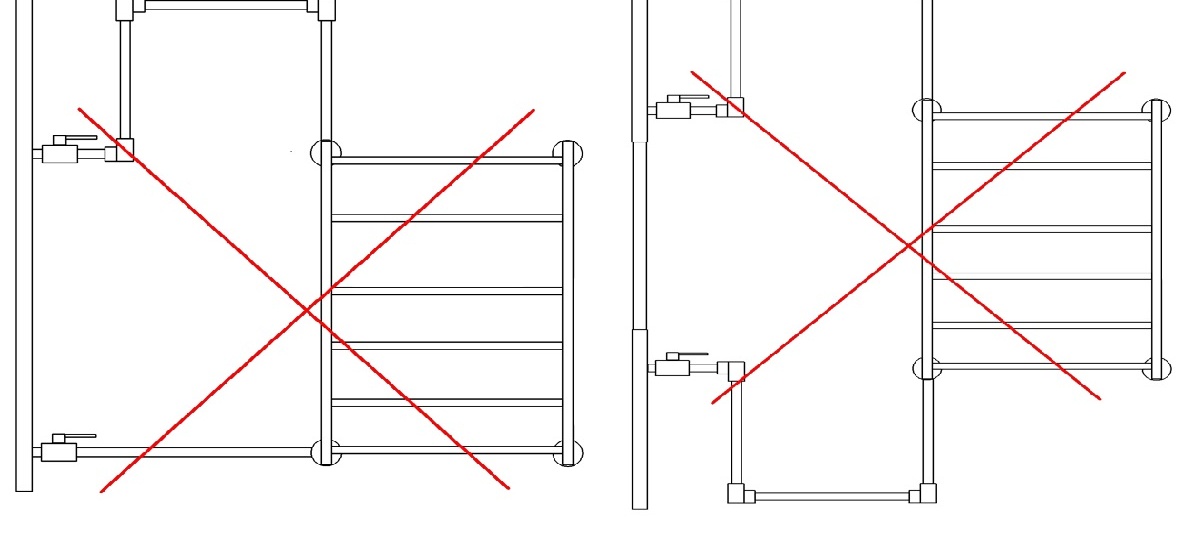
Attempts to hide the heated towel rail in the floor or behind the ceiling lead to the formation of "loops" that impede or completely stop the circulation of hot water
If the connection scheme includes a biased or narrowed bypass, then with a lower supply of coolant, the pressure of forced circulation can equalize with the efforts of the "gravity pump". In most cases this does not happen because the pump “wins”. Nevertheless, stopping the flow of hot water can provoke both lengthening the connecting lines and reducing their cross-section, and installing a tap on the bypass with one of your neighbors.
To correct the situation, a complete or partial change in the connection diagram is necessary. You may even need to transfer the “towel” to a new place. If such measures do not suit you, then you can correct the situation by installing a circulation pump in the circuit. The only thing that will be needed for this is to find out from the housing department specialists the direction of the coolant movement in the riser.
About all the features of moving a heated towel rail to another place, read here:https://aquatech.tomathouse.com/en/santehnika/polotencesushitel/perenos-polotencesushitelya-na-druguyu-steny.html
In all other cases, the recommendations of experienced plumbers should be considered. So, for all cases of lateral connection (including diagonal), the following conditions will be required:
- the upper outlet of the heated towel rail should be below the outlet of the riser, and the lower pipe - above the entry point of the return line;
- there should be no “loops” on the highway;
- the cross-section of the pipeline should take into account the hydraulic resistance of the coil;
- if the upper crossbar of the substation is higher than the hot water withdrawal point, then the heating device must be equipped with a Mayevsky tap.
With a lower connection, it will help to correct the situation:
- moving or changing the bypass section;
- observance of necessary biases and removal of "loops" from the scheme;
- ensuring the conditions under which the corresponding branches of the riser will be below the points of connection of the "towel".
Considering the scheme of the lower connection, it is necessary to analyze the direction of movement of the water flows when it is cooled in the coil and determine whether it will circulate at the upper or lower supply.
The erroneous opinion that without installing a narrowed bypass, water will not circulate along the coil of the device, leading to unjustified installation of bypass sections with a reduced passage section. But in a scheme with a lower flow of coolant and poor circulation, such a narrowing can just serve as the reason why the coil remains cold. The section of the bypass section should not be reduced by more than one step, and in the case of an offset bypass, this is not recommended at all.
If the heated towel rail does not heat up at a lateral or diagonal connection and an offset or narrowed bypass is used, then the direction of movement of the hot water in the riser should be checked. As noted above, with a lower flow, such circuits are inoperative due to the fact that the circulation of the coolant is impeded by the operation of the “gravity pump”.
You will receive more information about the methods of installing towel rails and installation technology by reading this article:https://aquatech.tomathouse.com/en/santehnika/polotencesushitel/ustanovka-i-podklyuchenie-polotencesushitelya.html
Causes of breakdowns and troubleshooting of electric heated towel rails
Electric heated towel rails (often called design radiators) have a sufficient margin of reliability, but, like any other equipment, they can fail due to exhaustion of the resource, internal defects, overheating or power surges.
Depending on the design, two types of electric design radiators are distinguished - solid and liquid. In the former, heat transfer is provided by graphite and other compounds, while the latter function by heating specially prepared water, antifreeze, or a mixture of mineral oils. In solid-filled design radiators, you can use either a traditional spiral or tubular electric heater, or a heating film or cable. Liquid “towels” are built using traditional “dry” or conventional heating elements.
You can learn more about choosing and connecting electric heated towel rails from this article:https://aquatech.tomathouse.com/en/santehnika/polotencesushitel/elektricheskij-polotencesushitel-dlya-vannoj.html
In order to find the cause of the breakdown of the electric heated towel rail, you need a multimeter, a set of screwdrivers and an adjustable wrench. The search begins with checking the integrity of the electrical circuit, gradually moving towards the power elements:
- check the presence of mains voltage in the outlet;
- “Call” the cord with a multimeter - its resistance should not exceed 1-2 Ohms;
- when the PS is turned on, the voltage at the terminals of its heater is measured. If the multimeter shows the presence of 220 V, then this is an indirect evidence of the failure of the heater;
To check the electric heater, a multimeter is used, which is included in the resistance measurement mode. Infinitely large value indicates an internal cliff. The resistance of a functioning heater should not exceed several tens of ohms.
- if there is no supply voltage at the heater terminals, the condition of the contact group or thermostat relay is checked - both the burning of the contacts and the poor electrical connection can serve as the cause of the failure;
- If an electronic thermostat is used to control the temperature of the heated towel rail, not a mechanical one, then the reason for the lack of voltage on the heating element is more difficult to find. First of all, you should check the output relay or power semiconductors - powerful transistors, thyristors or triacs of the output stage. When they are in good condition, other components of the circuit are checked. If you have no experience in repairing electronic devices, then it is better to entrust such work to a specialist.

All that is needed to diagnose and repair an electric heated towel rail is a multimeter, an adjustable wrench and a set of screwdrivers
It is not difficult to replace the heater in the heated towel rail. If the type of appliance is not known, then before disassembling the coil should be turned over so that the working fluid does not leak. Then, using a wrench, unscrew the nut on its flange, dismantle and replace the heater. Be sure to check for current leakage to the body of the design radiator. To do this, one probe of the multimeter is connected to the metal surface of the heated towel rail, and the terminals of the heating element are alternately touched with the others - the device should show infinitely high resistance.
Before assembling the heater, replenish the fluid level (if there were leaks or some of the oil leaked during operation), leaving room for thermal expansion. After that, the integrity of the gaskets is checked and, if necessary, replaced with new ones. Next, with a force sufficient to ensure tightness, tighten the flange nut and check the heater's performance in various modes.
Video: how to make a heated towel rail work
By making the heated towel rail work with proper thermal efficiency, you will not only increase the comfort of the bathroom, but also reduce the risk of mold and mildew. We hope this article will help you find and eliminate the reason why the heating device could not work properly. If your “towel” still remains cold, then you can ask our experts a question through the feedback form. Perhaps their advice will be the very saving straw that will bring the heating device back to life.
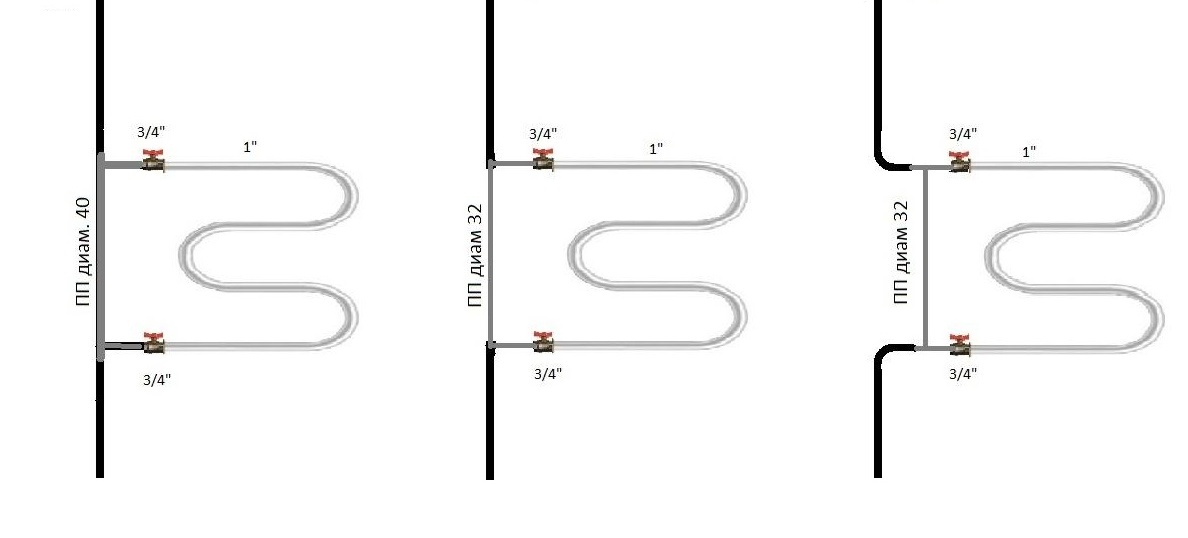
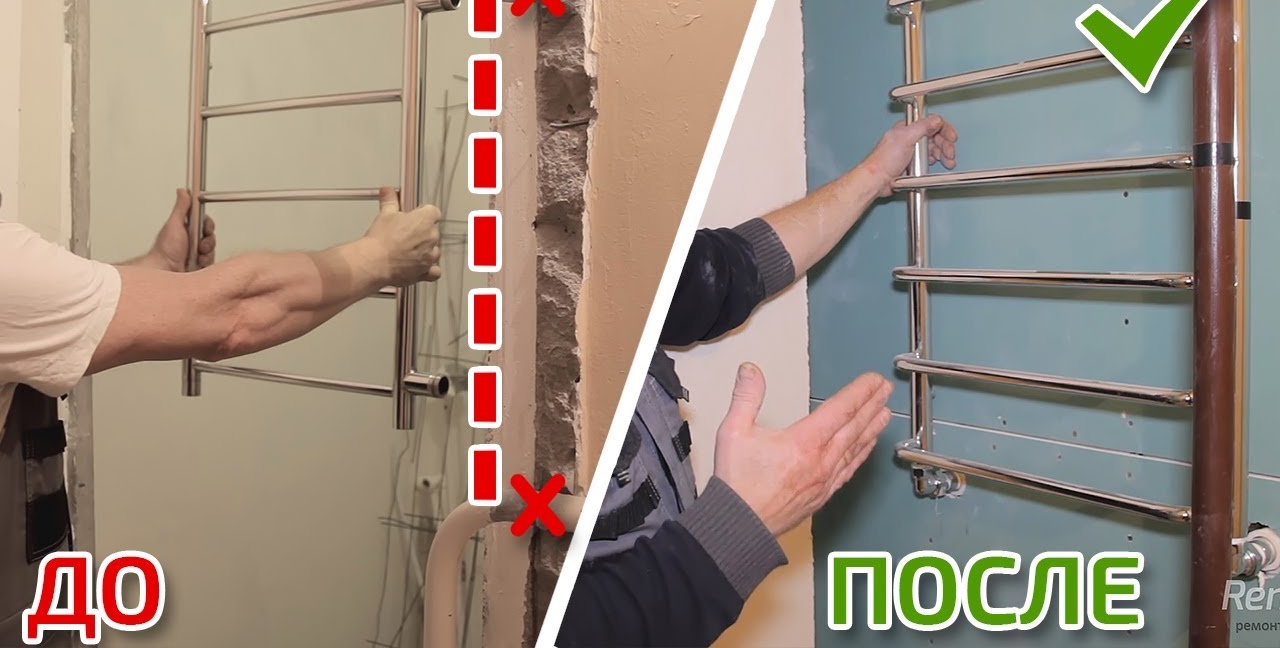
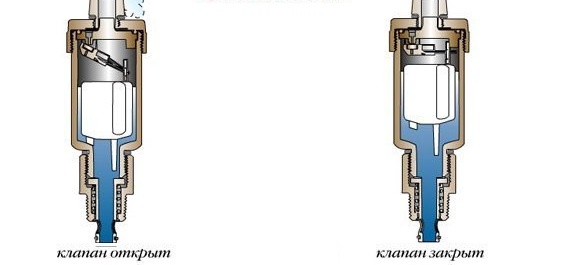
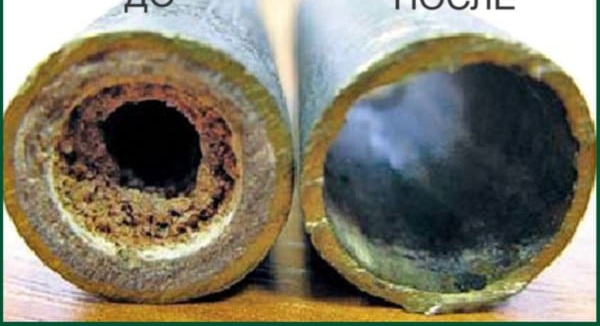
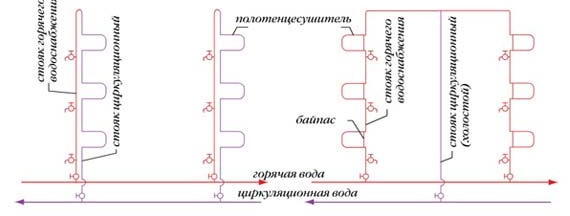
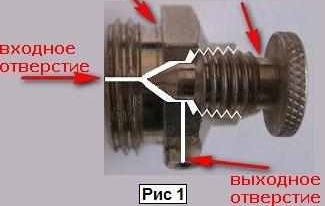
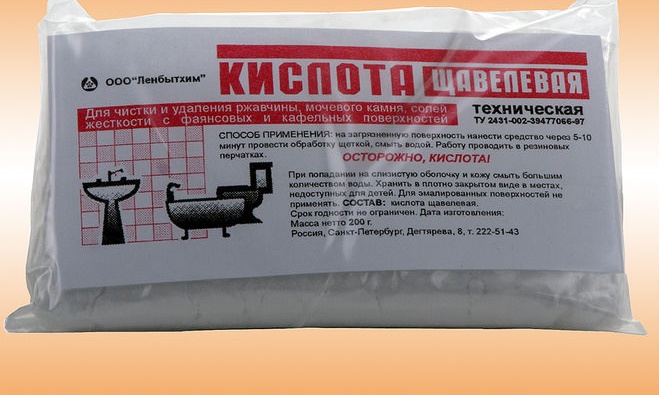


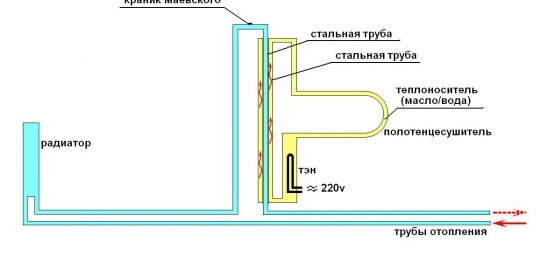


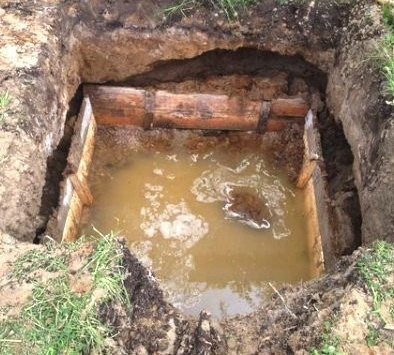
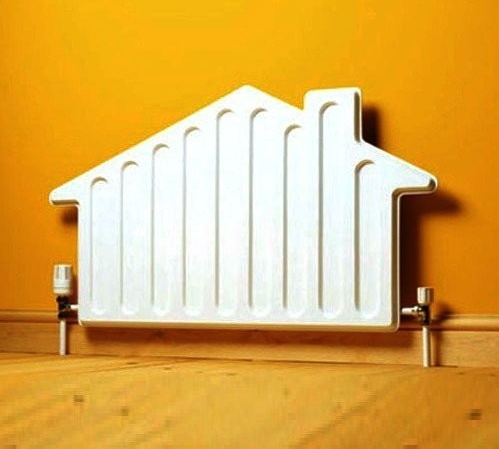
1 comment